
Crystal Bennes, installation view, Platform, Trinity Apse, Edinburgh Art Festival 2023. Photo: Sally Jubb.
Various venues, Edinburgh
11 – 27 August 2023
by BETH WILLIAMSON
This year’s Edinburgh Art Festival (EAF), like the 18 that have gone before it, is a cornucopia of exhibitions of various sorts to be experienced in different ways. With 55 projects and exhibitions across 35 venues, the idea of the festival might suggest enjoyment and pleasure, but it is much more than that. This year’s director, Kim McAleese, says she is interested in bringing “a sort of informality” to the programme and while that informality and relaxed atmosphere is evident in every aspect, it tackles serious issues. Through myriad forms of engagement – exhibitions, performances, discursive platforms, activism, chill spaces, residencies, Sunday salons, early career platforms – EAF asks: “Who has the right to speak and in what way?” From an all-night dance festival to an intimate book tent discussion, EAF this year foregrounds the importance of the local, of activism in all its forms, of the civic role of art and arts organisations for its audiences, partners and people.
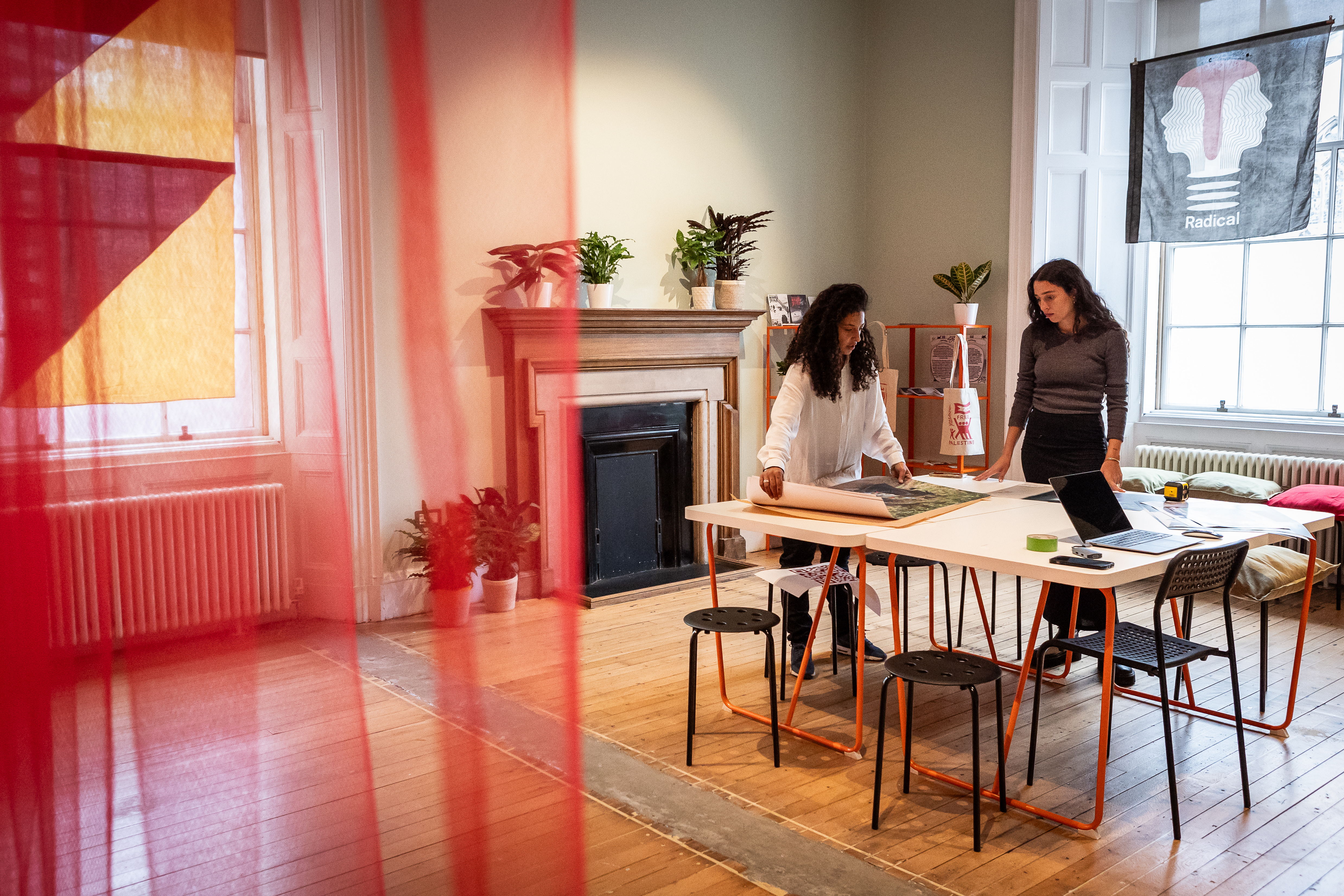
Haven for Artists, installation view, French Institute, Edinburgh Art Festival 2023.
In terms of individual shows, I can only give a flavour here of everything that is on offer. My visit began at the French Institute with an introduction to the work of Haven for Artists, a cultural feminist organisation based in Beirut, Lebanon. Working at the intersection of art and activism, Haven is a physical and digital platform supporting cultural works and knowledge production rooted in intersectional feminism, gender and racial justice, and decolonial practices. Their residency as part of EAF brings a programme of activities and connections with local organisations and initiatives. It sets the tone perfectly for the festival by providing a quiet space to relax, think and talk in the midst of such pressing issues.
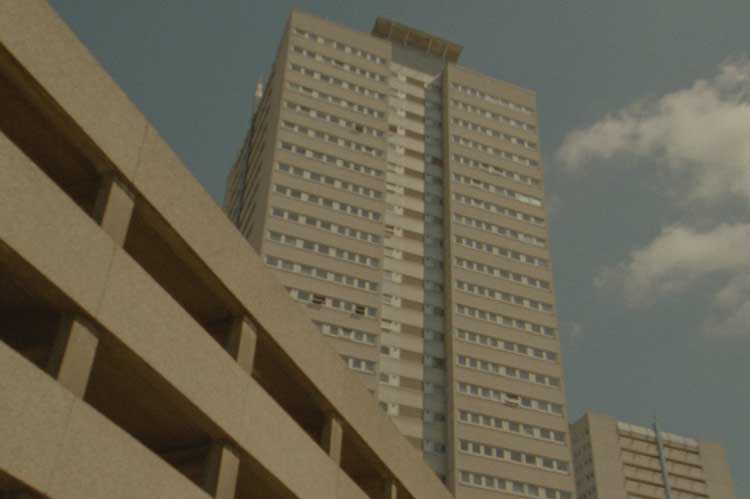
Sean Burns, Dorothy Towers, 2022. Film still. Courtesy of the artist.
Upstairs, Sean Burns’ Dorothy Towers project includes a powerful film, archive material and a series of public events. The captivating footage takes its points of reference from documentary, public information and artist’s films, with a particular nod to film- maker Nigel Finch’s documentary Chelsea Hotel (1981). The story in Dorothy Towers (2022) is that of the residents of Clydesdale and Cleveland Towers, two residential blocks in Birmingham, known locally as Dorothy Towers because of the prevalence of LGBTQ+ residents. Opened in 1971, the towers are in one sense material proof of the marginalisation and pigeonholing of their residents over the years. Burns’ film, however, shows how these individuals and their relationships have evolved, and can be celebrated as a flourishing community. At Talbot Rice Gallery, The Tower by Jesse Jones focuses its attention on a time of feminist opportunity before the European Witch trials and channels 13th-century mysticism. Jones’ durational performed installation involves viewers in an intensely affective experience.
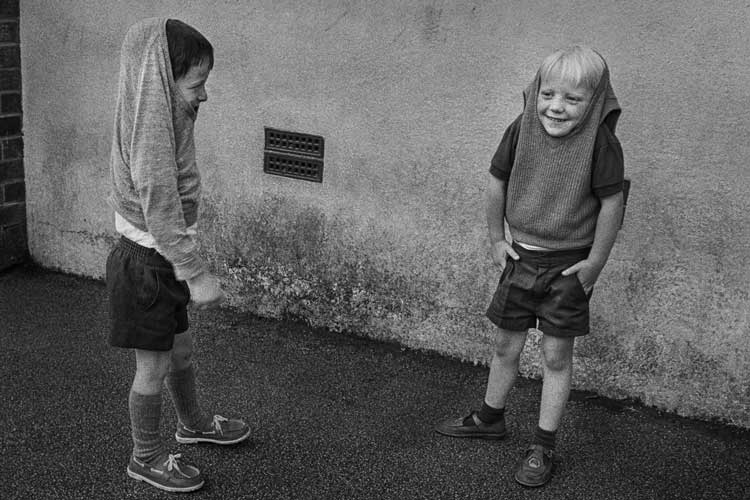
Markéta Luskačová, Two boys with their jumpers over their heads, Booker Avenue primary school, Liverpool, 1988. © Markéta Luskačová.
At Dovecot Studios, the exhibition Scottish Women Artists: 250 Years of Challenging Perception (until 6 January 2024), is particularly interesting in its thematic approach to cutting through diverse artists and their work across centuries. Meanwhile, Stills Centre for Photography presents the first exhibition in Scotland (until 7 October) dedicated to the work of Prague-born photographer Markéta Luskačová. Including work from a period of 40 years, Luskačová’s photographs range across locations in the UK, Ireland, Slovakia and the Czech Republic. These photographs celebrate children and childhood not as a sentimental remembering, but for what they are and what they can teach us. There is an accompanying publication Childhood (2023) from Bluecoat Press, and the exhibition will tour to the Centre for British Photography in London January to April 2024. Around the corner from Stills at the Fruitmarket, Leonor Antunes: The Apparent Length of a Floor Area continues until 8 October.
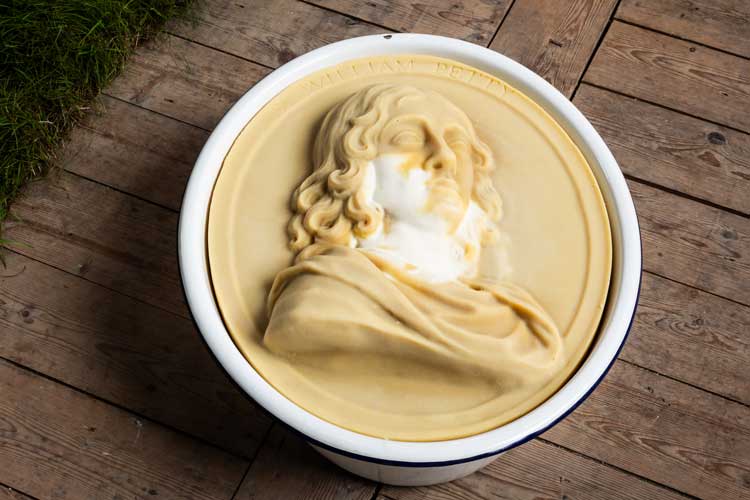
Crystal Bennes, The Surveyor General. Lye, oil, milk, water, enamel basin, 60 x 45 cm, 2023. installation view, Platform, Trinity Apse, Edinburgh Art Festival 2023. Photo: Sally Jubb.
Part way down Chalmers Close in Trinity Apse, Platform celebrates early career artists working in Scotland and this year features work by Aqsa Arif, Crystal Bennes, Rudy Kanhye and Richard Maguire. I was especially drawn to Bennes’ work, which is deeply researched, highly intelligent, and powerfully affective. Her subject is 1670s England and Ireland when poor English women were sent to be the forced wives of poor Irish men and, supposedly, improve their households through the transmission of English language and culture. Meanwhile, the products they made, such as butter, cheese and linen, were regarded as marketable and fair game for the colonial administrators to monetise. Bennes’ five-part installation turns on the flagrant exploitation of these women and their wares – the colonial and imperial control exerted on them. It is a horrific story and a fascinating one, too. One of those five parts is The Surveyor General, a milk soap sculpture made in an enamel basin, picking up on the earlier reference to dairy products and depicting the English Surveyor General of Ireland at that time. Bennes told me that, at the end of the exhibition, the sculpture will be cut up and sections given to visitors to take away. Symbolic payback, perhaps, for the 17th-century exchange of women that he engineered.
,-Instalation-view-at-Jupiter-Artland,-Photo-John-Mckenzie-09.jpg)
Lindsey Mendick, Sh*tfaced, 2023. Installation view at Jupiter Artland, Photo: John Mckenzie.
Beyond the city, in Jupiter Artland, Lindsey Mendick’s show Sh*tfaced (until 1 October) presents the viewer with three installations, taking Robert Louis Stevenson’s novella The Strange Case of Dr Jekyll and Mr Hyde (1886) as a point of reference for the duality often imposed on contemporary ideas of good and evil, virtue and depravity, and gender roles. Mendick’s signature ceramic tableaux spell out the dual standards and dark underbelly of contemporary binge-drinking culture in three installations: I Tried So Hard to Be Good (white ceramics on a mirrored table), Sh*tfaced (an off-kilter ceramic nightclub environment complete with toilet, and graffiti), and a confessional film full of shame and anxiety.
,-Instalation-view-at-Jupiter-Artland,-Photo-John-Mckenzie-07.jpg)
Lindsey Mendick, Sh*tfaced, 2023. Installation view at Jupiter Artland, Photo: John Mckenzie.
,-Installation-view-at-Jupiter-Artland,-Photo-John-Mckenzie-11.jpg)
Lindsey Mendick, I Tried So Hard to Be Good, 2023. Installation view at Jupiter Artland, Photo: John Mckenzie.
There are shows concurrent with EAF, including at Modern One (until 7 January 2024) where Alberta Whittle’s exhibition Create Dangerously promotes compassion and care to combat racism. At the National, Grayson Perry’s provocative Smash Hits (until 12 November) is proving to be a jam-packed blockbuster.
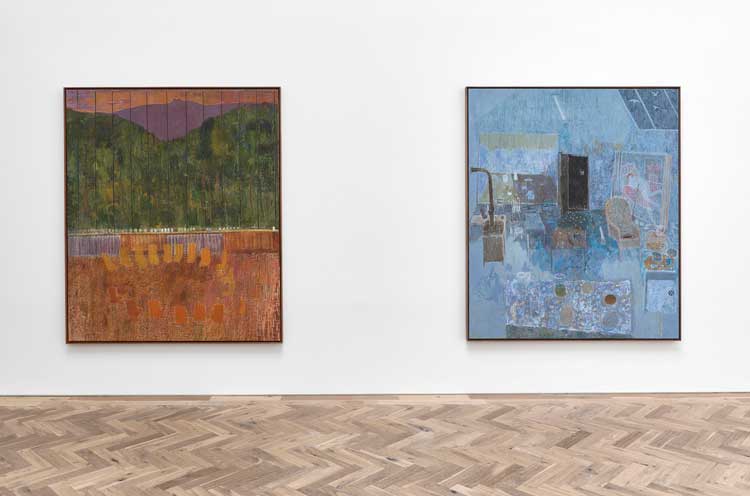
Andrew Cranston: Never a joiner, installation view, Ingleby, Edinburgh, 17 June – 16 September 2023. Photo: John McKenzie.
At Ingleby (until 16 September), Andrew Cranston’s quiet exhibition Never a Joiner shares exquisite narrative paintings. These large-scale works are present alongside book cover paintings he has become known for. In each case, the intimacy of the scenes depicted seems to be rooted in the history of painting while remaining entirely contemporary.
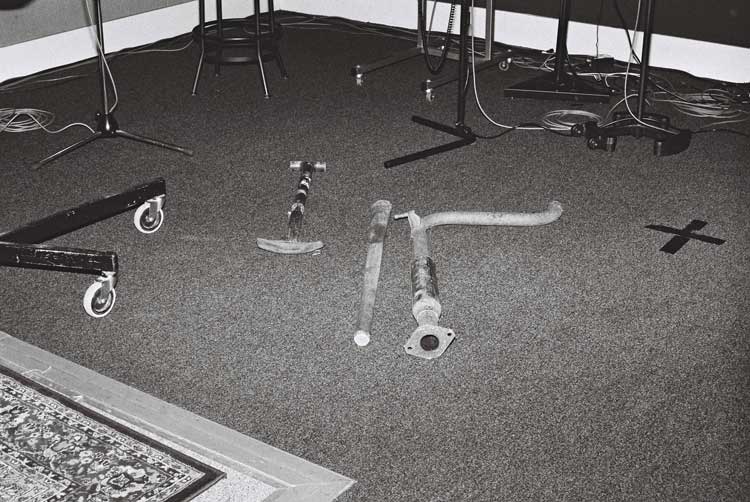
Maria Fusco, Margaret Salmon, History of the Present, 2023. Video and 35mm, 46 min. Production still. Courtesy of the artist.
One of the most astonishing shows of EAF was Maria Fusco and Margaret Salmon’s History of the Present, an experimental opera-film foregrounding working-class women’s voices. The social, political and cultural history of Northern Ireland is a difficult one and Fusco grew up beside a peace line in Belfast during the Troubles. Annea Lockwood’s composition and Héloïse Werner’s vocal improvisations leverage the acoustic qualities of the peace line. Ultimately, this work asks the same question that McAleese asked – who gets to speak and in what way?
McAlees’s vision for the festival is bolstered by a passionate and energetic team who have, through this year’s programme, made space for learning, listening and reflection, as well as sheer unadulterated joy. It is a festival that connects firmly to the people and communities in the city of Edinburgh while creating a space for what she calls “critical and nuanced global dialogue”. It is about helping people better understand the world we live in, their ability to support each other and to find new ways to mobilise individual and collective agency for good. Finally, it is about hope and a shared humanity, about moving forward in new ways with new understanding and remembering how the simplest of shared acts has the potential to change everything.